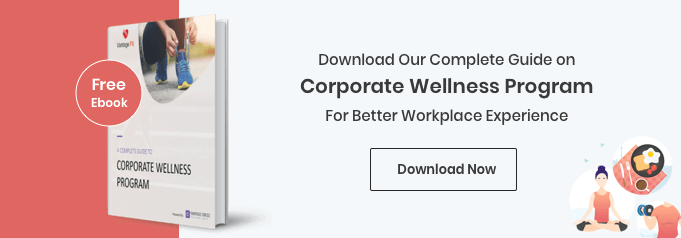Health Promotion At The Workplace: The Role of Managers

In the labyrinthine realm of today's fast-paced existence, where stress and sedentary lifestyles trap the unwary, the enigmatic puzzle of health promotion assumes paramount significance. Within this, human resources (HR) emerge as magicians, conjuring initiatives that weave a harmonious symphony of employee well-being.
The shortcomings of the professional healthcare systems introduced health promotion back in 1970. It's a critical strategy for elevating socioeconomic, psychological, and medical health.
Steep growth in self-care, community participation, and workplace health prevails in various sectors. Health promotion is becoming a fundamental issue for organizations under employee well-being strategies.
Around 53% of employers admit to being responsible for the welfare of their employees. Adopting measures like corporate wellness programs, health coaching, etc., is growing among them.
A study says that employees feel more well-being when they have organizational support. Managers having suitable resources and power can become health advocates for their employees.
They can take the opportunity to develop and enforce sustainable health promotion initiatives.
Before delving deeper, let's know the basics of workplace health promotion.
What is Health Promotion?

The 1986 Ottawa Charter by the WHO was a landmark in health promotion history.
It defines it as "the process of enabling people to increase control over, and to improve their health."
The key strategies, according to the charter, are:
- Building healthy public policy,
- Creating supportive environments,
- Strengthening community action,
- Developing personal
- Skills and reorienting health services
Workplace health promotion uses similar strategies for fostering well-being within the organization.
The collaborative efforts of employers, employees, and society help create a better workplace. It encourages personal and professional development and enhanced workplace engagements.
Importance of Health Promotion At Workplace

Employees spent most hours in the office, completing tasks and meeting deadlines. Rising workload stress and other health problems harm employees' productivity levels. Employees seek an organization catering to their emotional, financial, and wellness needs.
Employers are aware that healthy employees produce better business results. Hence, supporting them with health activities becomes imperative.
Some activities concentrate on a single health factor (like preventing diabetes) nine dimensions of wellness(like health fair). Employees having all nine elements save healthcare costs and job turnover. Hence, employers must promote health and wellness in their organization.
Some effective strategies for promoting physical activity in the workplace include offering on-site fitness classes or gym memberships, hosting walking or running challenges, and encouraging employees to take breaks and stretch throughout the day.
Public Health Initiatives in the United States
The Healthy People 2030 initiative is one of several public health programs in the US focused on improving health and wellness. This effort lays forth precise goals for raising health equity, lowering health inequalities, and enhancing health outcomes.
You may support a bigger objective of enhancing general health and wellness in the US by coordinating your workplace health promotion tactics with these public health programs.
Benefits of Workplace Health Promotion
Health promotion benefits the organization and employers on a large scale. There are various programs under health promotion that help employers in the following ways:
1. Reduced Absenteeism

Spreading awareness of eating nutritious foods will prevent them from gaining weight. That healthy workforce seldom misses its workdays due to medical issues. It inspires employees to follow the wellness regimes that will keep them fit.
2. Increased Productivity

Health Promotion includes programs like workplace Yoga, Health camps, workplace ergonomics. Active participation can help employees increase productivity and improve health.
3. Reducing Health Risks

Regular health checkups detect disease before it becomes severe. It helps with the prevention of chronic diseases like heart ailments and diabetes.
4. Reduced healthcare cost

Increasing health care costs is one of the significant concerns among employers. 70% of the health issues are preventable if not treated at the proper time can result in severe. Health promotion is a way to reduce costs by preventing the disease.
5. Reduced job turnover
One of the main reasons for turnover is job dissatisfaction due to work burnout. Activities like counselling by health educators are one way to know your employees. Studies show that employees are 81% less likely to seek a new job.
Role of Managers In Health Promotion
Managers have the authority to set up policies and objectives for the organizations. Poor management of health and safety issues may degrade the quality of the employees. It will affect the outputs of the organization and degrade its market value. Hence knowing the responsibility of a manager before enrolling in programs is essential.
Here are five ways you can play your role in health promotion.
5 Ways managers can do health promotion in the workplace:
1. Having Effective Communication

A manager with a clear idea of the subject will guide his employees well. Successful Health and wellness programs need the trust of your employees. Proactive participation is only possible if managers communicate with them. Communication is the prime factor for bridging the gap and strengthening the relationship.
Dynamic employers can bring a positive influence on their employees. Employees engage 59% more likely under their supervision.
2. Lead By Example

The approaches taken by managers are crucial to the success of health programs. Employers who engage themselves in health initiatives prove the true meaning of leadership. This involvement motivates its employees to adopt a healthy lifestyle. For example, if a manager participates in a walkathon, his employees will likely do the same.
3. Showing Care and Concern

A great manager always shows care and will ensure his employees feel valued. The study says that 38% of employees listen to their managers when they are valued. One way is by introducing initiatives under health programs. It will create emotional wellness and boost the morale of the employees. Employers can incentivize health promotion activities to suffice their employees' health needs.
4. Monitoring employees
Managers who know the likes and dislikes connect better with their employees. They can elevate engagements either through one-to-one sessions or survey questionnaires. Using an online application, they can track the participation of their employees.
Vantage Fit App helps in monitoring the fitness of employees in real time. Employers can run various Wellness campaigns and create healthy competition among employees. They can also motivate employees by rewarding them with fitness points.
Schedule a demo now and let Vantage Fit take care of your organization's health and wellness.
5. Empowering employees
Usually, employees complain about being uncomfortable while completing activities. Managers amplify wellness by empowering their employees to manage their health issues. They might allow employees to point out faults or alter wellness programs. Participation will make your employees confident and help them in their professional development.
Health Promotion Strategies
By using efficient health promotion techniques, HRs may enhance employee health outcomes, save healthcare costs, and foster a culture of health and well-being at work.
HRs may assist staff members in maintaining their health and achieving their full potential by identifying risk factors, prioritizing illness prevention, addressing health equality, collaborating with public health organizations, and encouraging physical exercise.
1. Finding Risk Factors
Finding common risk factors is one of the first stages in boosting employee health. HRs can evaluate workers' health hazards, such as obesity, hypertension, and high cholesterol. By knowing these aspects, HRs may create customized interventions to address these risk factors, like wellness programs or health coaching.
2. Emphasizing Disease Prevention
Prevention is key to reducing healthcare costs and improving employee health outcomes. HRs should educate employees on the importance of disease prevention, including regular health screenings, vaccinations, and lifestyle changes. By encouraging preventative health measures, HRs can help employees avoid serious health problems and reduce the need for expensive medical interventions.
3. Addressing Health Equity
HRs should be mindful of health equity and work to address disparities in healthcare access and outcomes. Employees from marginalized communities may face barriers to accessing healthcare and experience health disparities.
HRs can develop targeted health promotion programs that address the unique needs of different employee groups, such as providing language services or partnering with community organizations.
4. Promoting Physical exercise

A healthy lifestyle must include physical exercise. HRs may promote physical activity by giving staff members access to on-site fitness centers, providing fitness programs or rewards for exercise, and encouraging active transportation alternatives like bicycling and walking. HRs may assist workers in maintaining their health and lowering their risk of chronic illnesses by prioritizing physical exercise.
5. Collaborating with public health agencies
Working with public health organizations may effectively boost employee health and wellness. To give employees access to services like health screenings, immunizations, and instructional materials, HRs might collaborate with regional public health organizations. HR departments and public health organizations can collaborate to develop a culture of health and well-being at work.
Conclusion
The idea of health promotion is relevant to companies in the private and public sectors. The success of their organization depends on a healthy, motivated, and qualified workforce. A healthy employee will be more enthusiastic about his work and motivate his peers. A health-promoting workplace help reduce medical costs and absenteeism rates.
Managers play a vital role in designing health programs for their employees. Implementing it will improve employee health and the organization's bottom line. Evidence-based wellness programs help them live a more extended period of disease-free life.
Now I would like to hear from you.
In what ways do you do health promotion at the workplace?
Let me know in the comment section below!
Frequently Asked Questions (FAQs)
1. Why is health promotion important for employees?
Health promotion is important for employees because it can improve their well-being, enhance job satisfaction and productivity, reduce absenteeism and presenteeism, and lower healthcare costs for both employees and employers.
2. How can employers encourage employees to participate in health promotion programs?
Employers can encourage participation by promoting the benefits of the programs, offering incentives or rewards, providing flexible scheduling to accommodate participation, and creating a supportive and inclusive workplace culture.
3. How can employers address mental health in health promotion initiatives?
Employers can address mental health by implementing policies that reduce stigma, providing access to mental health resources and counseling services, offering flexible work arrangements, promoting work-life balance, and fostering a supportive and understanding work culture.








